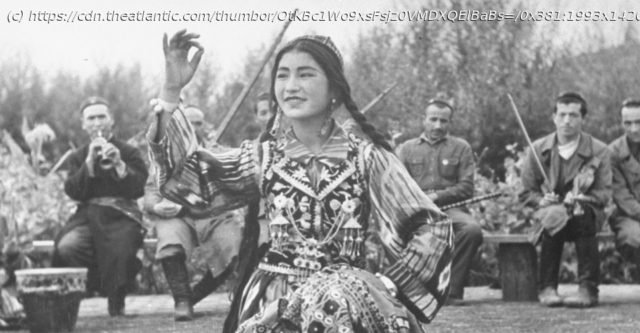China’s repression of the Uighurs in Xinjiang has forced those in the diaspora to protect their identity from afar.
How do you protect a culture that is being wiped out? For Uighurs, this is more than just a hypothetical. Repressive measures against the ethnic minority have progressively worsened: the Chinese government has corralled more than 1 million of them into internment camps, where they have been subjected to political indoctrination, forced sterilization, and torture. The targeting of the Uighurs isn’t limited to the camps: Since 2016, dozens of graveyards and religious sites have been destroyed. The Uighur language has been banned in Xinjiang schools in favor of Mandarin Chinese. Practicing Islam, the predominant Uighur faith, has been discouraged as a “sign of extremism.” Beijing frames these moves as its way of rooting out terrorism, separatism, and religious extremism. But the aim of China’s actions in Xinjiang is clear: to homogenize Uighurs into the country’s Han Chinese majority, even if that means erasing their cultural and religious identity for good. What is taking place is a cultural genocide. The repercussions bear heavily even on Uighurs living outside of the country. Their burden is more than just raising awareness about what is taking place in their homeland—a task many have taken up at great cost to themselves and their families. It’s also about preserving and promoting their identity in countries where few people might know who the Uighurs are, let alone what the world stands to lose should their language, food, art, and traditions be eradicated. In an effort to understand what this kind of cultural preservation looks like in practice, I spoke with seven Uighurs residing in Britain, France, Turkey, and the United States. As chefs, poets, singers, filmmakers, language teachers, and musicians, each of them is contributing to this work in different ways. All of them are passionate about ensuring that their heritage will be passed on to future generations. None of them are under any illusions about what’s at stake if they fail. “Every Uighur now is under very big psychological pressure,” Omer Kanat, the director of the Uyghur Human Rights Project, a Washington, D.C.–based nonprofit, told me. “We cannot sleep at night.” By April 2017, few people outside of Central Asia might have known much about the Uighurs. Though the ethnic group totals more than 11 million people in Xinjiang, about 1 million live outside China, mostly in Kazakhstan, Uzbekistan, and Turkey, with much smaller numbers in the United States and Europe. Reports of their persecution by the Chinese state wouldn’t reach wider international audiences until later that year. It was against this backdrop that Mukaddes Yadikar, a Uighur woman from Ili in the northwest of Xinjiang, near China’s border with Kazakhstan, decided to open Etles, one of London’s first Uighur restaurants. Nestled on a busy North London high street brimming with corner stores, betting shops, and cafés, Etles’s bright-blue exterior stands in marked contrast to much of its surroundings—a differentiation befitting of its distinctive offerings. Owing to the Uighur homeland’s place along the ancient Silk Road trade route, Uighur cuisine takes its influences from across Central Asia, incorporating dishes as seemingly disparate as hand-pulled noodles and crispy naan. Even diners accustomed to the culinary diversity of the British capital might not expect to find dumplings, samosas, and shish kebabs on a single menu. At Etles, however, these dishes are only a representative sample of what makes Uighur cooking unique. “Our food is very rich, very different,” Yadikar told me one Sunday afternoon over tea. Its absence from Britain’s food scene is what she said first inspired her to open the restaurant with her husband, Ablikim Rahman. At the time of its opening, Etles catered to a predominantly Chinese clientele—a trend Yadikar chalked up to Britons’ lack of familiarity with Uighur cuisine. In the years since, that has changed. “Now most of our customers are English,” Yadikar said, adding that their menu has appealed to many within the British Muslim community, for whom halal Chinese food can often be difficult to find. Today, the couple runs two North London restaurants (the second opened in December, just months before the pandemic forced both locations to close). Etles feels like a living homage to Uighur culture. Etles silks, the traditional Uighur cloth from which the restaurant gets its name, are laid across every table. A tapestry of the artist Ghazi Ehmet’s Uyghur Muqam, one of the most recognizable paintings in Xinjiang, is prominently featured at the center of the dining room. Every wall is adorned with models of traditional instruments, embroidered caps, and decorative plates. When I asked Yadikar and Rahman about the role they see themselves playing in protecting Uighur culture, they paused for several seconds. It’s not a question many people are asked to consider. The silence was filled by their three young children who, sitting one table over, were clamoring over schoolwork. In a way, they answered the question for their parents. “We’re just [trying to] pass our culture, identity, and religion to the next generation,” Rahman said, nodding to the kids. Though the children speak Uighur fluently at home, only two of them have been to Xinjiang, and are too young to remember it. So Yadikar and Rahman keep the spirit of their homeland alive at Etles. “From the restaurant, we can introduce our people, our culture, and our traditions,” Yadikar said. “We can’t go [to Ili]; we can’t see our people. They can’t leave. So we have to introduce our people then; we have to protect.” Few understand the exhausting task of piecing a culture back together like Devin Naar. For nearly two decades, the historian and Sephardic-studies professor at the University of Washington has sought to understand and recuperate the lost world of Sephardic Jewry, an effort that began when he was in college. His interest in the topic stems from his own family history, “a puzzle” he says spans from the Greek port city of Salonica (now known as Thessaloniki), where one of the world’s largest Sephardic Jewish communities once lived, to the substantial Sephardic population in Seattle, where he currently resides. Toward the end of the 15th century, the Iberian Peninsula was home to one of the largest Jewish communities in the world. That is, until 1492, when Spain issued its Jewish population an ultimatum: to convert, leave, or be killed. As many as hundreds of thousands of expelled Sephardic Jews (deriving from the Hebrew word for Spain, Sepharad) sought exile in places such as Portugal (which not long after delivered a similarly stark demand), Italy, and the Netherlands. Others, like Naar’s ancestors, made their way to the Ottoman empire. “They didn’t speak either Greek or Turkish at home, but they spoke a language that they called Spanish,” Naar told me of his ancestors in Salonica. In fact, like other Sephardim, they spoke a centuries-old variant of Spanish known as Ladino, which uses Hebrew script. Growing up in the U.






